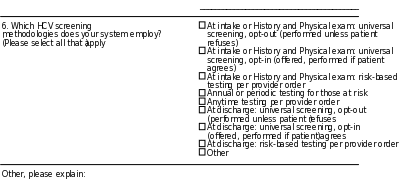Comprehensive Understanding of Readiness for Elimination
[NCHHSTP] Comprehensive Understanding of Readiness for Elimination of Hepatitis C in Corrections (Cure-HepC) Survey
Att 3a Survey_CLEAN
OMB:
Confidential
Page |
Form Approved
OMB No. 0920-XXXX
Exp. Date XX/XX/20XX
Comprehensive Understanding of Readiness for Elimination of Hepatitis C in Corrections (Cure-HepC)
Public reporting burden of this collection of information varies from 10 to 30 minutes to complete, with an average time to complete of 20 minutes. An agency may not conduct or sponsor, and a person is not required to respond to a collection of information unless it displays a currently valid OMB control number. Send comments regarding this burden estimate or any other aspect of this collection of information, including suggestions for reducing this burden to CDC/ATSDR Information Collection Review Office, 1600 Clifton Road NE, MS D-74, Atlanta, Georgia 30333; ATTN: PRA (0920-XXXX).
The goal of this survey is to understand practices surrounding hepatitis C virus screening, testing, and treatment.
Each responding system will receive a request to complete this web-based survey. The survey has branching logic to improve efficiency and reduce the time burden for completing this survey. Participating systems will have a set-time period, as determined by the survey team, to complete the survey. The survey will be self-administered. Please answer the survey questions to the best of your ability.
Thank you!
__________________________________

The first set of questions are about your system.

-
Other, please explain:
__________________________________________
4. What is the average length of stay (in days) of the confined and/or detained population in your system?
__________________________________
(Please answer in whole numbers)

The next set of questions are about hepatitis C virus (HCV) testing practices within your system
HCV screening consists of testing for the presence of antibodies to HCV, and if reactive, testing for HCV RNA to diagnose current infection.
Reflex testing means automatically performing HCV RNA testing on patients with a reactive
HCV antibody using the same blood sample.
HCV screening may consist of single-step HCV RNA testing for populations with high rates of recent HCV exposure.

________________________________________

(Reflex testing means HCV RNA testing is performed automatically on patients with a positive HCV antibody using the same blood sample)
Other, please explain:

__________________________________________
The next set of questions are about hepatitis C treatment practices within your system.
7. What criteria was utilized to select and prioritize your confined and/or detained population who had hepatitis C infection for treatment? (Please select all that apply).

Length of stay
Blood tests (i.e., liver function test, APRI, FIB-4)
Prescence of co-existing illness
Liver imaging
Age
Participation in substance use treatment or programming
Previous history of hepatitis C treatment
History of discipline and/or incidents during current confinement
None, universal hepatitis C treatment policy
Other
Other, please explain: |
__________________________________________ |
|
__________________________________ |
|
|
8. What clinical practice guideline(s) did you use to initiate treatment for your confined and/or detained population for hepatitis C infection? (Please select all that apply).
American Association for the Study of Liver Diseases
Federal Bureau of Prisons HCV clinical
In-house developed HCV clinical guidance
Patient seen by outside specialist
Not applicable
Other
Other, please explain: __________________________________________


__________________________________________
Do you offer medication for opioid Yes
use disorder (MOUD) to your confined and/or detained population No
undergoing treatment for hepatitis C infection who have an opioid Other
use disorder?
Other, please explain:
__________________________________________
The next set of questions are about hepatitis C treatment opportunities and barriers within your system.

Please identify challenges you have encountered in your efforts to Medication cost
treat your confined and/or detained population who have Medication access
hepatitis C infection. Inadequate nursing
staffing
Laboratory cost
(Please select all that apply). In-house provider access/adequacy
Specialist Provider access/adequacy
Patient non-compliance
Linkage to community providers on discharge
Access to medical services on discharge
No or Inadequate data systems
Length of stay
None of the above
Other
Other, please explain: |
__________________________________________ |
||
12. What is your single greatest challenge in testing and treating your confined and/or detained population who have hepatitis C infection? |
__________________________________________ (Please thoroughly explain) |
||
13. Is there anything else you would like to convey regarding your ability to test and treat hepatitis |
|
|
|
regarding your ability to test and treat hepatitis C |
|
|
|
infection among your confined and/or detained population? |
__________________________________________ |
|
|
|
(Please thoroughly explain) |
|
|
![]()
| File Type | application/vnd.openxmlformats-officedocument.wordprocessingml.document |
| File Modified | 0000-00-00 |
| File Created | 0000-00-00 |
© 2025 OMB.report | Privacy Policy